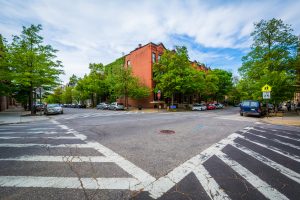
When it comes to road safety, pedestrians are one of the most vulnerable populations in our community. We are ALL pedestrians. Every time you walk your dog, cross the street or check your mailbox, you may encounter motorists.
In 2021, 135 pedestrians were killed in Maryland. We want to discuss the statistics and highlight the most common risk factors contributing to these preventable fatalities.
Maryland Pedestrian Crashes
Pedestrian crashes involve at least one motor vehicle and one person traveling on foot near a public road, whether they’re standing, walking, or running, and include motorists getting out of their vehicles. Pedestrians are extremely vulnerable in these cases, even when the vehicles involved are not traveling at high speeds. Over the past five years in Maryland, an average of 125 pedestrians have died in crashes annually.
- These crashes have a high fatality rate. Maryland drivers are involved in about 3,000 crashes involving pedestrians every year. In 2021, these crashes accounted for less than 3% of total crashes but nearly 23% of statewide fatalities. From 2017 to 2021, one out of every four people killed in Maryland in a traffic crash was a pedestrian.
- Metropolitan areas have the highest concentration of pedestrian-involved crashes. Between 2017 and 2021, 92% of pedestrian-involved crashes occurred in the Baltimore and Washington metropolitan areas. Although most pedestrian-involved crashes took place in Baltimore City (31%), Prince George’s County accounted for the greatest number of crashes resulting in a fatality (24%).

It is not surprising that like nationwide statistics, pedestrian-involved crashes in our state are more likely to occur in densely populated areas. It also follows that pedestrian-involved crashes are more likely to occur on the weekend, with Fridays and evenings being the most dangerous times. On average, Friday was the peak day for pedestrian crashes (17%). However, the highest percentage of fatal crashes occurred on Saturdays (17%). More than half (54%) of all pedestrian crashes occurred between 2 p.m. and 10 p.m.; however, 50% of pedestrian crashes resulting in fatalities occurred between 6 p.m. and midnight.
Additional statistics regarding pedestrian-involved crashes within the state:
- More men are injured in pedestrian-involved crashes, accounting for 56% of injured pedestrians and 72% of fatalities.
- Young adult drivers and pedestrians (ages 20-34) account for a large percentage of pedestrian-involved crashes, with just over 25% involving drivers 34 and younger. Pedestrians between 20 and 34 accounted for 28% of those struck by vehicles or involved in a crash where an injury occurred; however, older pedestrians (50 and older) accounted for 44% of those involved in fatal crashes.
Slowing Down Can Literally Save a Life

We know pedestrians are vulnerable on roadways, and in a pedestrian and vehicle collision, the pedestrian is likely to be seriously injured or killed. However, we also know that speed has a tremendous impact on the outcome of a pedestrian-involved crash. At 20 mph, the likelihood of severe injury or fatality is 10%. At 40 mph, the likelihood of severe injury or fatality rises to 80%—meaning a pedestrian struck by a motorist at 40 mph is EIGHT times more likely to die than a pedestrian struck at 20 mph. It’s something to remember the next time you’re driving through a residential area and thinking that going a few mph over the speed limit won’t make a difference.
Walk Smart and Drive Smart!
When you’re out walking, make sure you’re alert for vehicles. Even if you see them, they may not see you. Always cross at designated intersections and look left, right and left again, before you cross the road. Remember, pedestrian safety laws are in place to keep you safe, so you should follow them every time—whether you’re walking or driving.
As a driver, remember that you’re responsible for obeying all traffic safety laws. Pay close attention in urban areas and when turning at intersections. Put away all distractions and keep your eyes on the road. Together we can keep everyone safe on Maryland’s roads.